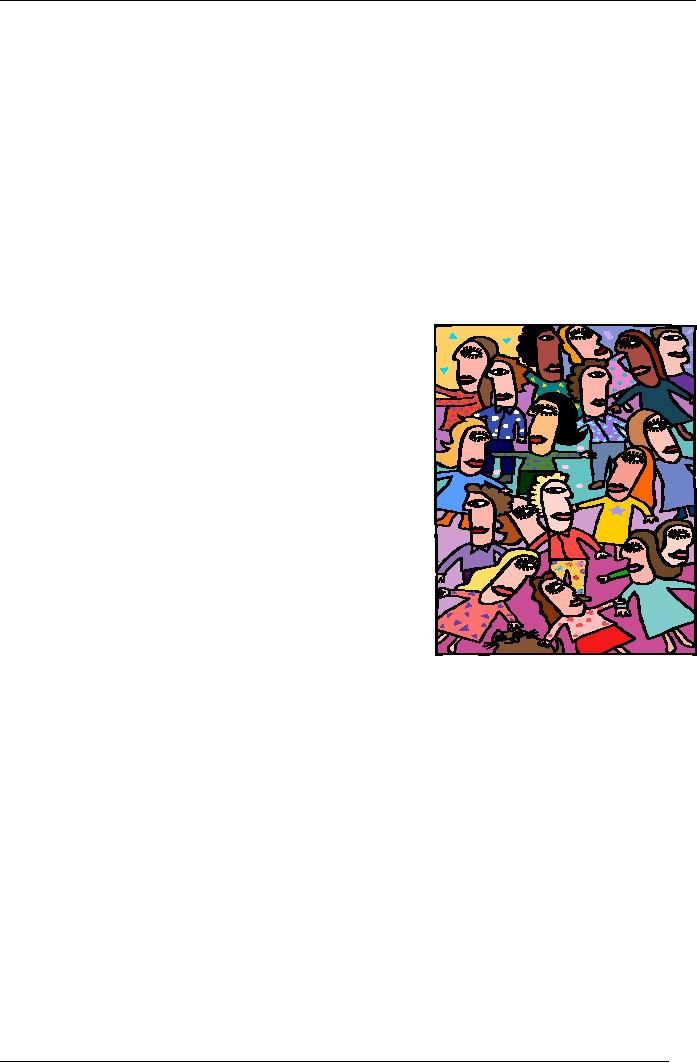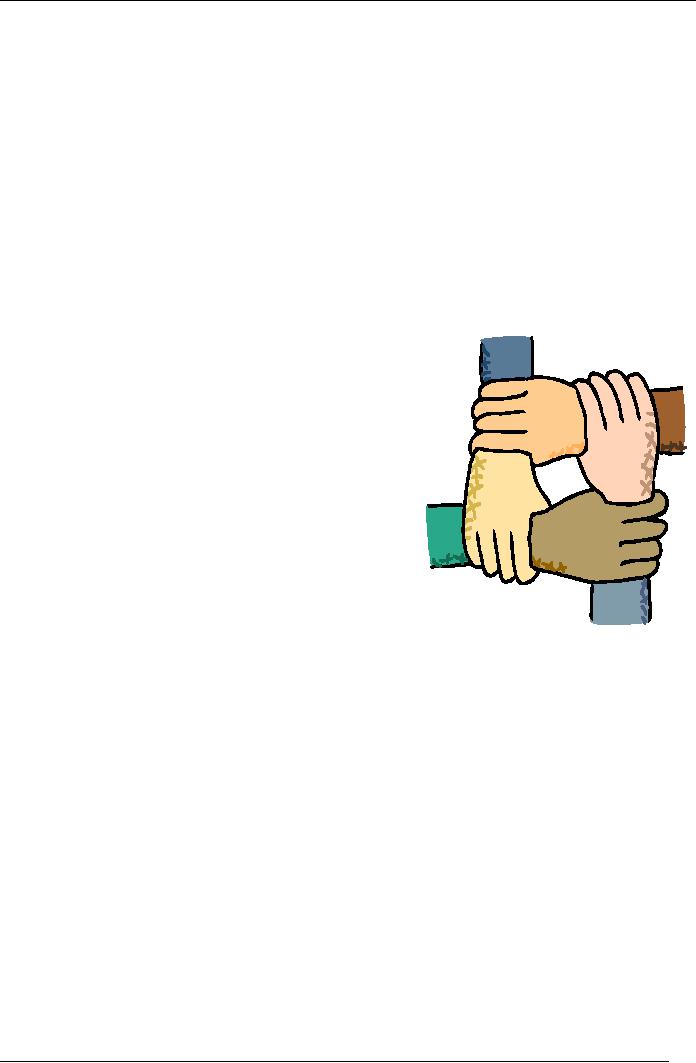 |

Human
Resource Management
(MGT501)
VU
Lesson
8
WORK
PLACE DIVERSITY
After
studying this chapter, students should be
able to understand the
following concepts:
A.
Work Force Diversity
B.
Sources of work force
diversity
C.
Managing the diversified
work force
LESSON
OVERVIEW
One
of the greatest challenges facing
organizations today is managing workforce
diversity in a way that
both
respects
the employees' unique attitudes and
promotes a shared sense of corporate
identity. This
chapter
explores
the issues that are
intrinsic to diversity management. In the
United States, as abroad, the
design and
implementation
of HR programs cannot ignore the diverse
nature of the work force. Thus, by the
end of
this
chapter the reader should have a better
grasp of diversity issues and
how to handle them
successfully
A.
Work Force Diversity
Any
perceived difference among people: age,
functional
specialty,
profession, sexual orientation,
geographic origin,
life
style,
tenure with the organization, or position.
Diversity simply
refers
to human characteristics that
make people different.
The
sources
of individual variations are complex,
but they can
generally
be grouped into two categories:
those over which
individuals
have little or no control
and those over
which
individuals
have more control. Unless
effectively managed,
diversity
among employees may have a
negative impact on
productive
teamwork. Affirmative action is not
diversity
management.
Affirmative action emerged from
government
pressure
on business to provide greater
opportunities for
women
and
minorities. Managing diversity is an outgrowth of natural
or
environmental
trends such as demographic
changes and
international
competition. Moreover, diversity is
considered an
asset
in terms of improving organizational
functioning and
reflecting
the customer market.
B.
Sources of work force
Diversity
Today
diversity refers to far more than skin
color and gender. It is a broad term
used to refer to all kinds of
differences.
These differences include women in
business, dual-career families,
workers of color,
older
workers
persons with disabilities,
immigrants, young persons with
limited education or skills,
educational
level
of employees.
i.
Racial & Ethnical
Groups
ii.
Older Workers
iii.
Gender
iv.
Education
v.
Dual-career Families
vi.
Religions & Culture
vii.
Persons with Disabilities
viii.
Immigrants
ix.
Young persons with limited
education or skills
x.
Competitive advantage though
work force diversity
xi.
Marketing
xii.
Creativity, innovation, and
problem solving
xiii.
Flexibility
40

Human
Resource Management
(MGT501)
VU
i.
Racial
& Ethical Groups: Workers
of color often experience
stereotypes about their
group
(Hispanics,
African Americans, Asians,
etc.). At times, they encounter
misunderstandings and
expectations
based on ethnic or cultural
differences.
ii.
Older
Workers--as
the world population is growing
older, a trend that is
expected to continue
through
the year 2000. In addition, the
trend toward earlier retirement
appears to be reversing itself.
iii.
Gender
(Women in Business): Women
represent almost 11.9 percent of
corporate officers at
largest
companies. However, the number of women
in entry and midlevel
managerial positions has
risen
from 34 percent in 1983 to 46
percent in 1998, meaning
many more women are in
the
pipeline
to executive spots. Today,
there are more than 9
million women-owned businesses, up
from
400,000 in 1972. The number of
nontraditional, single-parent households
in the United States
is
growing. Because more than half of
all marriages today end in divorce, this
trend is expected to
continue.
Often, one or more children
are involved. Of course,
there are always widows
and
widowers
who have children as well,
and there are some
men and women who
choose to raise
children
outside of wedlock.
iv.
Education:
Another
form of diversity that is now
found in the workplace is that of the
educational
level
of employees. The United
States is becoming a bipolar
country with regard to
education, with
a
growing number of very educated people on
one side and an alarming
increase in the illiteracy
rate
on the other.
v.
Dual-Career
Families: The
increasing number of dual-career families
presents both
challenges
and
opportunities for organizations. As a
result of this trend, some firms have
revised their
policies
against
nepotism to allow both partners to
work for the same company.
Other firms have
developed
polices to assist the spouse of an
employee who is transferred.
When a firm wishes to
transfer
an employee to another location, the
employee's spouse may be
unwilling to give up a
good
position or may be unable to
find an equivalent position in the new
location. Some
companies
are
offering assistance in finding a
position for the spouse of a
transferred employee.
vi.
Religion
and Culture: Due to
globalization religion and culture
based diversity is also
increasing
in
organizations.
vii.
Persons
with disabilities: A
handicap, or disability, limits the
amount or kind of work a
person
can
do or makes achievement unusually
difficult. The Americans
with Disabilities Act
(ADA),
passed
in 1990, prohibits discrimination against
qualified
individuals with
disabilities.
viii.
Immigrants:
Today
the permitted level of legal immigration
is increasing. Some are
highly skilled
and
well educated, and others
are only minimally qualified
with little education. They
have one
thing
in common--an eagerness to work. They
have brought with them
attitudes, values,
and
mores
particular to their home-country
cultures.
ix.
Young
persons with limited
education or skills: Each
year thousands of young,
unskilled
workers
are hired, especially during
peak periods, such as
holiday buying seasons. In
general, they
have
limited education--high school or
less. More jobs can be
de-skilled, making it
possible for
lower-skilled
workers to do them.
x.
Competitive
advantage through Work Force Diversity:
For
many years' organizations,
the
original
impetus to diversify their workforces
was social responsibility and
legal necessity.
Morally
ethically
it was right to do so. Today
many organizations are
approaching diversity efforts from
a
moral
practical, business oriented
perspective,. Increasingly, diversity can be a
powerful tool for
building
completive advantage. Companies with a
reputation for providing
opportunities for
diverse
workforce will have a completive
advantage in a labor market
and will be sought out by
the
most
qualified employees, In addition when
employee believe their
differences are not
merely
tolerated
but valued , they may become
more loyal, productive and
committed.
41

Human
Resource Management
(MGT501)
VU
xi.
Marketing:
Companies
are realizing that consumers,
like the workforce, are
changing
demographically.
Just as women and minorities
may prefer to work for an employer
that values
diversity,
they may prefer to patronize such
organizations. A multicultural workforce
can provide a
company
with greater knowledge of th preferences
and consuming habits of thus
market place.
This
knowledge can assist companies in
designing products and developing market
campaigns to
meet
those consumer needs. A
diverse workforce can also
give company competitive edge in a
global
economy by facilitating understanding of
other customers, cultures,
and market place
needs.
xii.
Creativity,
innovation, and problem Solving: Work
team diversity promotes creativity
and
innovation,
because people from different
backgrounds hold different
perspective on issues.
Diverse
groups have a broader base of
experience from which to
approach problem; when
effectively
managed, they invent more
options and create more
solutions than homogeneous
groups
do. In addition, diverse workgroups
are freer to deviate from
traditional approaches
and
practices.
xiii.
Flexibility:
A
diverse workforce can
enhance organizational flexibility
because successfully
managing
diversity requires a corporate culture that
tolerates many different
styles and
approaches.
Less
restrictive polices and procedures
and less standardized operating
methods enable
organization
to become more flexible and
thus better able to respond
quickly to environmental
changes.
xiv.
Diversity
Management and Affirmative Action
Programs: We can
define the workforce
diversity
management as set of activities involved
in integrating diverse employees into the
work
force
and using their diversity to the
firm's competitive
advantage
C.
How organization Cultivate a Diverse
Workforce:
An
Organization's plans for becoming
multicultural and making the most of
its diverse workforce
should
include:
I.
Securing
top management support and
Commitment
II.
Organizational
Assessment
III.
Attracting
employees
IV.
Developing
Employees
V.
Retaining
employees
I.
Securing top management support and
commitment: Obtaining
top-level commitment
and
support is critical for diversity programs to
succeed. One way to communicate
this
commitment
to all employees as well as to the
external environment is to incorporate the
organization's
attitudes toward diversity into the
corporate mission statement and
into
strategic
plans and objectives. Managerial
compensation can be directly
linked to
accomplishing
diversity objectives. Adequate funding
must be allocated to diversity
effort
to
ensure its success. Also,
top management can set an
example for other
organization
members
by participating in diversity programs
and making participation mandatory for
all
managers.
Top management or diversity directors
alone cannot do the work fof
mamnagin
diversity.
Many companies rely on minority
advisory groups or task
forces to monitor
organizational
policies, practices, and
attitudes; access their
impact on the diverse
groups
within
the organization; and provide feedback
and suggestions to top
management.
II.
Organizational Assessment: The
next step in managing diversity is to
assess the
organization's
workforce, culture, policies, and
practices in areas such as
recruitment,
promotions,
benefits, and compensation. In
addition, the demographics of the labor
pool
and
the customer base should be evaluated.
The objective is to identify problem
areas and
make
recommendations where changes
are needed.
42

Human
Resource Management
(MGT501)
VU
III.
Attracting Employees: Companies
can attract a diverse,
qualified workforce through
using
effective
recruiting process, accommodating
employees' work and family
needs, and
offering
alternative work arrangements.
IV.
Developing Employees: Employees
can be developed in a variety of ways.
Here we will
focus
on skills training and diversity
training.
V.
Retaining Employees: As
replacing qualified and
experienced workers become
more difficult
and
costly, retaining good workers
will become much more
important. A number of
policies
and strategy will increase
retention of all employees,
especially those who
are
"different"
from the norm.
STEPS
TOWARD MANAGEMENT OF
DIVERSITY
a.
Managing
Diversity means
taking steps to maximize diversity's
potential advantages
while
minimizing
the potential barriers, such as
prejudices and bias that
can undermine the functioning of
a
diverse workforce.
b.
Boosting
Workforce Diversity Employers
use various means to boost
workforce diversity: start
diversity
programs; have departmental diversity
meetings; form
special
networking
and mentoring groups; and/or
direct recruiting ads
to
one or
more
of the online minority-oriented job
markets
c.
Equal
Employment Opportunity Versus
Affirmative
Action
Equal employment opportunity aims to
ensure that
anyone,
regardless of race, color,
sex, religion, national
origin,
or
age, has an equal chance
for a job based on
his/her
qualifications.
Affirmative action goes beyond
equal
employment
opportunity by requiring the employer to
make
an
extra effort to recruit, hire, promote,
and compensate
those
in protected groups to eliminate the
present
effects
of past discrimination.
d.
Affirmative
Action: Two
Basic Strategies The
good
faith
effort strategy is aimed at
changing the practices
that
contributed to minority groups' or
females' exclusion or
underutilization.
The quota strategy mandates
bottom-line results through
hiring
and
promotion restrictions.
Challenges
in Managing Employee Diversity
Diversity
offers opportunities as well as
challenges. The challenges include
appropriately valuing diversity,
balancing
individual needs and group
fairness, dealing with
resistance to change, ensuring
group
cohesiveness
and open communication, avoiding employee
resentment, keeping the focus on
performance,
retaining
valued performers, and maximizing
opportunity for all
employees.
a.
Resistance
to Change: Although
employee diversity is a fact of life, the
dominant groups in
organizations
are still composed of white
men.
b.
Segmented
Communication Networks: One
study found that most
communication within
organizations
occurs between members of the
same sex and race.
Therefore diversified
workforce
organization
may face the challenge of
segmented communication networks.
c.
Resentment:
Equal employment
opportunity that can be
defined as fairness of employment that
is
free
from all sort of discrimination in
majority of organizations was a forced
change rather than a
voluntary
one.
d.
Backlash:
While
women and minorities may
view a firm's "cultural diversity policy"
as a
commitment
to improving their chances
for advancement, white men
may see it as a threat.
How
to avoid Backlash: Many
organizations that have instituted
diversity programs have
experienced
43

Human
Resource Management
(MGT501)
VU
adverse
reactions from employee groups,
particularly white men. Here are some
guidelines for HR professionals
and
company
managers who are attempting to manage diversity
without adversity.
i.
Adopt an inclusive definition of
diversity that addresses all kinds of
differences among employees,
including
(but
not limited to) race and
gender.
ii.
Make sure that top
management is not only
committed to establishing a diversity
program but also
communicates
that commitment directly to all
employees
iii.
Involve everyone, including
white men, in designing the diversity
program.
iv.
Avoid stereotyping groups of employees,
such as white men, when explaining
cultural or ethnic
differences
v.
Recognize and reward white men who
are part of the solution rather
than blaming men who are part of
the
problem.
vi.
Avoid one-time training
efforts that stir up
emotions without channeling them in
productive directions. Use
ongoing
training that encompasses diversity as
only one facet of needed change in the
corporate culture.
e.
Retention:
The
job satisfaction levels of
women and minorities are
often lower than those of
white
men.
f.
Competition
for Opportunities: As
minority populations grow in the
U.S., competition for
jobs
and
opportunities is likely to become
much stronger.
g.
Lower
Cohesiveness: Diversity
can create a lack of
cohesiveness. Cohesiveness' refers to
how
tightly
knit the group is and the
degree to which group
members perceive, interpret
and act on their
environment
in similar or mutually agreed
upon ways. Because of their
lack of similarities
language,
culture,
and/ or experience, diverse
workforce typically are less
cohesive than homogeneous
groups.
Often
mistrust, miscommunication, stress
and attitudinal differences
cohesiveness, which inurn
can
diminish
productivity.
h.
Communication
problem: Perhaps
the most common negative effect of diversity
is
communication
problems. These difficulties include
misunderstanding, inaccuracies, and
slowness.
speed
is lost when not all group
members are fluent in the
same language or when additional time
is
required
to explain things.
i.
Diversity
also increases errors and
misunderstandings. Group
members may assume
they
interpret
things similarly when in fact they do not
,or they may disagree
because of their
different
frames
of references .
j.
Mistrust
and tension: People
prefer to associate with others
who are like themselves.
This
tendency
often leads to mistrust and
misunderstanding of those who
are different because of
lack of
contact
and low familiarity. it also
causes stress and tension
,and reaching agreement on
problems
can
be difficult.
k.
Stereotyping:
We
learn to see the world in a certain
way based on our backgrounds
and
experiences.
Our interests, values and
cultures act as filters and
distort, block and select
what we see
and
hear. We see and hear what we
expect to see and hear.
Group members often
inappropriately
stereotype
their "different" colleagues rather than
accurately perceiving and evaluating
those
individual's
contributions, capabilities aspirations
and motivations. Such
stereotypes inurn affect
how
people employee stereotyped as
unmotivated or emotional will be given
less -stress
provoking
jobs than their coworkers.
Those job assignments will
create frustrated employees,
perhaps
resulting in low commitment, higher turnover,
and underused skills.
Key
Terms
Affirmative
Action:
Steps
that are taken for
eliminating the present effects of
past discrimination
Cohesiveness:
Refers
to how tightly knit the
group is and the degree to
which group members
perceive,
interpret and act on their
environment in similar or mutually
agreed upon
ways
44
Table of Contents:
- INTRODUCTION TO HRM:Growing Importance of HRM, Road Map of the Course
- ESSENTIALS OF MANAGEMENT:Concepts and Essential of Management, Manager’s Roles
- ORGANIZATION AND COMPONENTS OF ORGANIZATION:Open versus Closed Systems, The Hawthorne Studies
- PEOPLE AND THEIR BEHAVIOR:Why to work in organizations?, The Goals of Organizational Behavior
- INDIVIDUAL VS. GROUP BEHAVIOR:What Are Roles?, Problem solving Team
- PERSONNEL MANAGEMENT TO HUMAN RESOURCE MANAGEMENT:Records and Administration, Competitive Advantage
- HRM IN A CHANGING ENVIRONMENT:Productivity, New Trends at Work Place
- How organization Cultivate a Diverse Workforce, STEPS TOWARD MANAGEMENT OF DIVERSITY
- FUNCTIONS AND ENVIRONMENT OF HRM:Compensation and Benefits, Safety And Health, Interrelationships of HRM Functions
- LINE AND STAFF ASPECTS OF HRM:Authority, Line versus Staff Authority, Staff Manager
- LEGAL CONTEXT OF HR DECISIONS:Doing the Right Thing, Affirmative Action, Unintended Consequences
- HUMAN RESOURCE PLANNING (HRP):Benefits of HR Planning, Forecasting Human Resource Availability
- STRATEGIC PLANNING AND HRIS:HR’s Strategic Role, Human Resource Information System, Common HRIS Functions
- JOB ANALYSIS:Purposes of the job Analysis, Questions Job Analysis Should Answer
- JOB ANALYSIS:Methods of Collecting Job Analysis Information, Observation, Source of Data
- JOB ANALYSIS (CONTD.):SURPLUS OF EMPLOYEES FORECASTED, Diversity through Recruiting Efforts
- SOURCES OF RECRUITMENT:ALTERNATIVES TO RECRUITMENT, Quantity of the Applicants, Quality of the Applicants
- SELECTION:Initial Screening, Advantages of Successful Screening
- SELECTION TESTS:Characteristics of Properly Designed Selection Tests, Guidelines for Conducting an Interview
- SELECTION PROCESS… CONTD:Background Investigations, Physical Exam, Selecting Managers
- SOCIALIZATION:Compensation and Benefits, Team Membership, Stages in socialization Process, Training and Development Trends
- TRAINING AND DEVELOPMENT:Learning, Phases of Training, Why Transfer of Training Fails
- MAXIMIZING LEARNING:Following up on Training, Repetition, Feedback, Purposes of T & D
- CAREER MANAGEMENT:Individual career planning, Career Planning and Development Methods
- PERFORMANCE:Determinants of Job Performance, Why is performance measured?, Performance Management
- PERFORMANCE APPRAISAL:What to Evaluate, The Appraisal Interview, PROBLEMS IN PERFORMANCE APPRAISAL
- JOB EVALUATION AND PRICING:THE APPRAISAL PERIOD, Ranking method,
- COMPENSATION SYSTEM:Pay, Job Pricing, Compensation: An Overview, Compensation Surveys
- BENEFITS:Total Compensation, Discretionary Benefits (Voluntary), Workplace Flexibility
- ROLE OF MONEY IN PERFORMANCE OF EMPLOYEES:Types of Pay-for-Performance Plans, Empower Employees
- MOTIVATION:The Motivation Process, Motivational Theories, Challenges of motivating employees
- OCCUPATION, HEALTH & SAFETY:Physical Conditions, Accident Investigation, Smoking in The work place
- STRESS MANAGEMENT:Symptoms of Stress, Managing Stress,
- COMMUNICATION IN ORGANIZATION:Burnout, Social Support at Work & Home, Communication in organization, Meetings
- TRADE UNIONS:Collective Bargaining, The HRM Department in a Nonunion Setting, Phases of Labor Relations
- CONFLICT AND NEGOTIATION:Transitions in Conflict Thought, Individual Conflict Management Styles
- POWER AND POLITICS:Sources of Power, Advantages and Disadvantages of PowerPower and Politics in Context
- EMPLOYEE RIGHTS AND DISCIPLINE:Contractual Rights, Management Rights, Disciplining Employees,
- DISCIPLINE (CONT...):Factors to Consider when Disciplining, Disciplinary Guidelines, Employee Separations
- LEADERSHIP:The Leader’s Behavior, Situational Theories of Leadership, Becoming a Leader
- REVISION (LESSON 12-21):Plans, Job Specification, Human resource planning, Selection Process, Corporate Culture
- REVISION (LESSON 22-26):Training, Case Study Method, Training, Performance
- REVISION (LESSON 27-35):Classification Method, Compensation, Empowerment, Mediation
- INTERNATIONAL DIMENSIONS OF HRM:Global Corporation, Type of staff members, Approaches to Global Staffing
- CONCLUSION & REVIEW:Strategies for Gaining Competitive Advantage, High-performance Work System